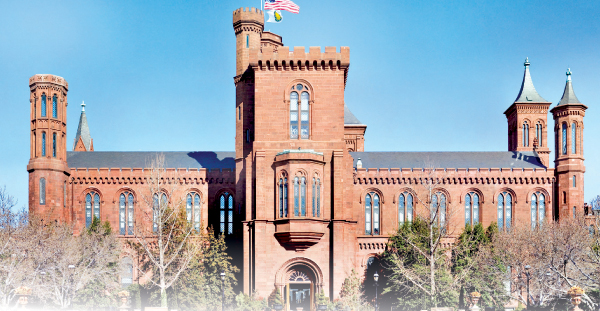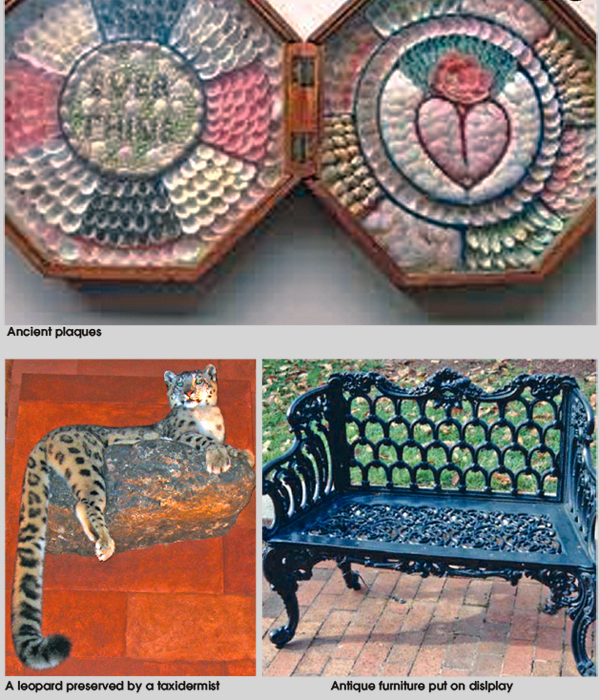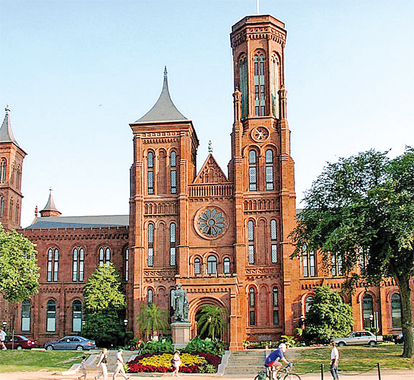|
The Smithsonian Institution:
World's largest museum complex
 The world's largest museum complex, the Smithsonian Institution
houses an impressive medical sciences collection. It dates from 1876,
when about 600 crude drug specimens, displayed at the Centennial
Exhibition in Philadelphia, were deposited in the U.S. National Museum.
Since then it has grown into one of the largest collections of medical
objects in the world, encompassing almost all fields of medicine and
health care. The world's largest museum complex, the Smithsonian Institution
houses an impressive medical sciences collection. It dates from 1876,
when about 600 crude drug specimens, displayed at the Centennial
Exhibition in Philadelphia, were deposited in the U.S. National Museum.
Since then it has grown into one of the largest collections of medical
objects in the world, encompassing almost all fields of medicine and
health care.
The medical sciences collection is a part of the National Museum of
American History (14th Street and Constitution Avenue, NW). Administered
by the Division of Science, Medicine, and Society, the diverse
collection includes patent medicines, drug-manufacturing apparatus and
containers, biologicals, alternative medicines, laboratory equipment,
eyeglasses, prosthetics and artificial organs, surgical instruments,
dental equipment, microscopes, radiology and other body imaging devices,
diagnostic instruments, quack medical devices, veterinary medicines,
uniforms, public health materials and biotechnology instrumentation.
These are supplemented by trade catalogues, posters, advertising
literature, business records and audiovisual and manuscript materials.
Some of the earliest fauna and flora specimens at the Smithsonian's
National Museum of Natural History (10th Street and Constitution Avenue,
NW) date from the 1850s. Federally sponsored expeditions such as the
United States Mexican Boundary Survey (1848-1855), Pacific Railroad
Survey (1853-1855) and Northwest Boundary Survey (1857-1861) had
physician-naturalists accompanying the surveying teams. These
expeditions produced large collections of animals and plants which were
deposited at the Smithsonian. Many physician-naturalists, including
Caleb B.R. Kennerly, James G. Cooper, George Suckley, Adolphus L.
Heermann and John S. Newberry, contributed to early collection building
at the Smithsonian.
The Smithsonian Institution is a research institution founded by the
bequest of James Smithson, an English scientist. Smithson, who died in
1829, had stipulated in his will that should his nephew and heir himself
die without issue, his remaining assets would pass to the United States
and be used to found the Smithsonian Institution. The nephew died,
heirless, in 1835, and the U.S. government was apprised of the
endowment.

Although it was held by John C. Calhoun and other members of Congress
that the federal government had no power to accept such a gift, it was
finally secured, largely through the efforts of John Quincy Adams. By
1838 the estate had been liquidated and the resulting $508,318.46 was
passed to the U.S. government.
Because the intent of Smithson's bequest was vague-he merely stated
that the funds should be used for the "increase and diffusion of
knowledge among men"-there was considerable disagreement over how the
money was to be deployed. Conceptualized as a university during early
discussions, the cornerstone for the Smithsonian Institution building
was laid the following year on the National Mall in Washington, D.C. The
building-inspired by Norman architecture and designed by James Renwick
was completed in 1855. Smithson's remains would eventually be reinterred
there.
When in 1901 the institution was alerted to the imminent disturbance
of his grave in Italy because of mining in the area, regent Alexander
Graham Bell began advocating for the remains to be shipped to the United
States.
In 1903 he travelled to Italy and supervised their disinterment. They
were installed in a crypt in the building-known as the Castle-two years
later.
The Smithsonian continued to expand and by the turn of the 21st
century its various constituent museums housed over 1.3 million
artefacts, among them many American "national treasures." The
institution comprised more than 15 museums and a number of research
centres; over 160 institutions were affiliated. Among the notable items
held by the institution were the massive blue Hope diamond the
`Columbia' command module from the Apollo 11 Moon-landing mission, and
the flag that inspired Francis Scott Key to write the lyrics of "The
Star-Spangled Banner" in 1814.
The Smithsonian also maintained significant ethnographic and natural
history collections, among them John Wesley Powell's record of his
research on Native Americans in Colorado, a diverse array of more than 4
million fossils, and the National Herbarium, which preserved 4.5 million
plant specimens. The institute also cared for pop-culture esoterica,
such as the ruby slippers worn by Judy
 |
|
Facade of the Smithsonian
Institution |
Garland in the film The Wizard of
Oz Slightly more than one percent of these items were on display; most
were in storage or research areas of the various museums or in a
facility in Maryland.
The Smithsonian is governed by a board of regents consisting of the
U.S. vice president, the chief justice of the United States, three
senators appointed by the president pro tempore of the Senate three
representatives appointed by the speaker of the House of
Representatives, and nine U.S. citizens chosen by the board and approved
by joint resolution of Congress.
The board administers the Smithsonian's budget. Trust funds account
for approximately a third of the institution's operating costs; the
remainder comes largely from annual congressional appropriations.
The Smithsonian magazine, first issued in 1970, is published by the
institution, as is Air & Space, first issued in 1986. Smithsonian
Networks, a television channel featuring documentaries and shows related
to Smithsonian holdings, was launched in 2007.
-Internet |

